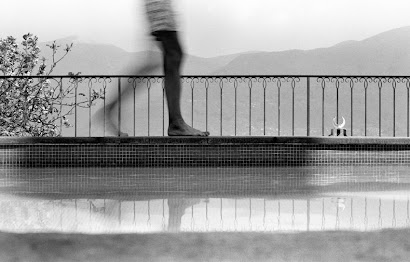A stranger had recorded my father's plane crash at an air show in Luxembourg on their video camera. We were given the tape by the police. There was a chaos of feelings and thoughts when we first watched the footage: The possibility to finally witness the unbelievable truth with our own eyes and to access the last few seconds of his life (hundreds of people had been there but none of us). The curiosity of watching it happen in visual images (out of sheer disbelief)- the reality of it. The indignation at someone else's curiosity and the voyeuristic aspect of recording it on film. The tormenting question: Did he suffer? The absolute horror of knowing what will happen in the next moment and the inability of preventing it. The undeniable proof. The fixed end of his life at that very moment.
As I kept rewinding the tape over and over again it seemed to me that I could undo the accident simply by operating the tape, reversing the flight, untangling these last ill-fated spins and fixing the wing back on… it felt as though I gained some kind of grasp. I could get lost in the moment before the accident and occupy myself with questions like: Why and how did it happen?, Whose fault is it?, Could it have been avoided?, Who did he think of in those last moments?
I could ignore the fact that it actually did happen. I could, in a way, suspend Death, my father being dead even though all else was rather irrelevant now.
We visited the scene of the accident on the same day. I photographed the landscape, the fields, the tree he had hit that had torn off the right wing, the corn fields that contained pieces of the plane, the air and the hole, where the cockpit had dug itself into the earth. I photographed my mother’s and my brother’s mourning, kneeling on the ground where the wreck of the plane had just been removed from and the planes in the sky above our heads that seemed to indifferently carry on the show with their joyful numbers. The amount of emotion was tremendous. Shock. Grief. Anxiety. Anger. Numbness. Panic. I had to put something between myself and the world to gain distance from it. Subconsciously, I hoped for answers through photography.
We visited the scene of the accident on the same day. I photographed the landscape, the fields, the tree he had hit that had torn off the right wing, the corn fields that contained pieces of the plane, the air and the hole, where the cockpit had dug itself into the earth. I photographed my mother’s and my brother’s mourning, kneeling on the ground where the wreck of the plane had just been removed from and the planes in the sky above our heads that seemed to indifferently carry on the show with their joyful numbers. The amount of emotion was tremendous. Shock. Grief. Anxiety. Anger. Numbness. Panic. I had to put something between myself and the world to gain distance from it. Subconsciously, I hoped for answers through photography.
Weeks later we were given permission to examine the plane wreck itself. I photographed it from every feasible angle, without injuring myself on the sharp, ravaged metal body. Ironically, for the first time I had come to understand my father’s fascination of planes. I wanted to know what each fragment's function was as part of the whole. Strangely, every piece on its own appeared beautiful to me because I knew with how much passion he had looked after it. The whole looked like a peculiar work of art to me that my father had left behind for us. There were so many questions that could not be answered; merely the camera provided some sort of substitute for closure.
In hindsight, it is evident that after the accident photography was my only means to regain any form of control of the present situation. I recorded everything. I even took a photograph of myself, minutes after talking to my mother on the phone and hearing the inconceivable words from her "No... he is dead". Time instantaneously stood still and no one was available to talk to. By taking a photograph of myself I was subconsciously making time pass again, as a taken photograph is a fulfilled act and an elapsed moment.
Later, I took pictures of my father’s belongings, exactly the way he had left them when he left the house for the last time. I knew that soon they would inevitably be moved with the ruthless continuation of everyday life. I was in panic about his existence vanishing so unexpectedly, about the sudden deprivation of his powerful and protective presence as the head of the family.
Things were to change very abruptly indeed, as my mother had, on the contrary, decided to leave everything behind as quickly as possible and to not only move homes but even countries. Within two months everything had gone, the home I had grown up in and the traces of my father.
As it was not possible to see his body which would have initiated the normal grieving process, I seemed to be creating my own evidence. I was trying to understand that what had happened was real and that it had to be accepted. It seemed as though photographs made it, in a way, more acceptable. They were transforming it into a part of my life and into past time. Recorded, printed and collected time, put into boxes. The pieces of a puzzle which bears the obscurity of his death.



